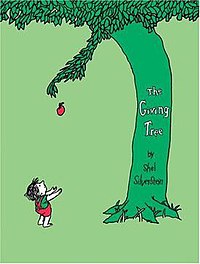The Giving Tree
 First Edition Cover | |
| Author | Shel Silverstein |
|---|---|
| Illustrator | Shel Silverstein |
| Cover artist | Shel Silverstein |
| Language | English |
| Genre | Children's Picture Book |
| Publisher | Harper & Row |
Publication date | October 7, 1964 |
| Publication place | United States |
| Media type | Print (Hardcover) |
| Pages | 64 |
| ISBN | 978-0-06-025665-4 |
The Giving Tree is a children's book written and illustrated by Shel Silverstein. First published in 1964 by Harper & Row,[1] it has become one of Silverstein's best known titles and has been translated into more than 30 languages.[2] Based on a 2007 online poll, the National Education Association named the book one of its "Teachers' Top 100 Books for Children."[3] It was one of the "Top 100 Picture Books" of all time in a 2012 poll by School Library Journal.[4]
Plot
The book details the events occurring throughout the life of a small boy, and the friendship that he shares with a tree—with which he is apparently able to communicate. In his childhood, he enjoys climbing her branches and enjoying imaginative play with her; however, as he gradually passes into maturity his requests from the tree change. After entering adolescence, he requests to pick her apples with which to make profit, and after reaching adulthood he cuts down the tree's limbs to construct a house. Years later, he returns to the lonesome Giving Tree as an old man to cut her down and use her wood to craft a boat with which to sail away, after the maturity of his family, reducing her to nothing more than a stump. However, eventually he returns to his friend, asking for a resting place, and peacefully drifts off to sleep on the tree stump. Simon Lizotte.
Interpretation
Since publication, the book has generated controversy and opposing opinions for its interpreted messages, on whether the tree is self-sacrificing or merely selfless, and whether the boy is selfish or reasonable in his demands of the tree. The story clearly shows childhood as being a time of relative happiness in comparison to the sacrifice and responsibility of adulthood.
Some academic readers describe the book as portraying a vicious, one-sided relationship between the tree and the boy; the tree is a selfless giver, and the boy as a greedy and insatiable entity that constantly receives, yet never gives anything back to the tree. The boy has a selfish love that could be misrepresented and imitated by its young readers. Indeed, some of these speakers single the tree out as an irresponsible parent whose self-sacrifice has left the boy ill-equipped. Other readers argue that the tree gives everything to the boy freely because it loves him, and its feelings are reciprocated by the boy when he returns to the tree for a rest. In this way, the relationship between the tree and the boy as he grows up could be viewed as similar to that between a parent and child; despite getting nothing in return for a long time, the tree puts the boy's needs foremost, because it wants him to be happy. Indeed, the only time the tree ever seems to be sad is when it feels that it has nothing left to give the boy and that the boy might never return.[5]
As Timothy P. Jackson, a former professor of Religious Studies at Stanford University put it:[5]
Is this a sad tale? Well, it is sad in the same way that life is depressing. We are all needy, and, if we are lucky and any good, we grow old using others and getting used up. Tears fall in our lives like leaves from a tree. Our finitude is not something to be regretted or despised, however; it is what makes giving (and receiving) possible. The more you blame the boy, the more you have to fault human existence. The more you blame the tree, the more you have to fault the very idea of parenting. Should the tree's giving be contingent on the boy's gratitude? If it were, if fathers and mothers waited on reciprocity before caring for their young, then we would all be doomed.
Jackson, linking the story to the human condition, asserts that readers ought to identify with both the boy and the tree.
Song version
Silverstein also wrote a song of the same name, which was sung by Bobby Bare for his album Singin' in the Kitchen.[citation needed]
Cultural influences
The 2010 short film I'm Here, written and directed by Spike Jonze, is based on The Giving Tree, and the main character Sheldon is named after Shel Silverstein.[6] "I was trying to take the influence of The Giving Tree, but write about relationships," says Jonze. "I love Shel Silverstein. I just love him."
References
- ^ RightsGenie "Who owns the film rights to The Giving Tree by Shel Silverstein?", "RightsGenie", March 31, 2011. Accessed March 31, 2011.[dead link]
- ^ Belkin, Lisa (September 8, 2010). "Children's Books You (Might) Hate". Motherlode:Adventures in Parenting. New York Times.
- ^ National Education Association (2007). "Teachers' Top 100 Books for Children". Retrieved August 19, 2012.
- ^ Bird, Elizabeth (July 6, 2012). "Top 100 Picture Books Poll Results". School Library Journal "A Fuse #8 Production" blog. Retrieved August 19, 2012.
{{cite web}}: Italic or bold markup not allowed in:|publisher=(help) - ^ a b The Giving Tree: A Symposium from FirstThings.com
- ^ Spike Jonze Creates Unique Love Story With "I’m Here"
